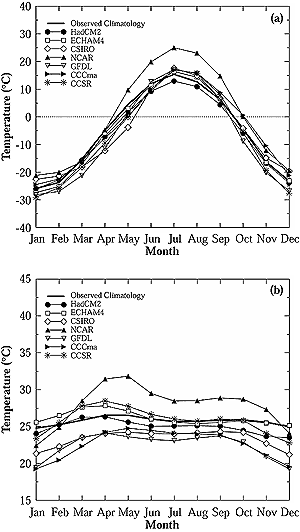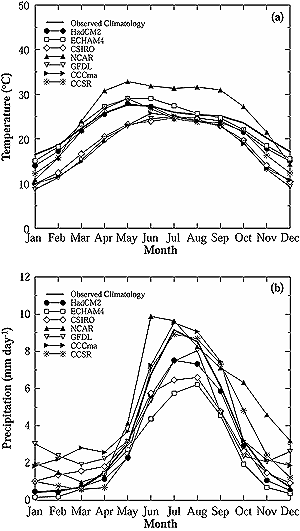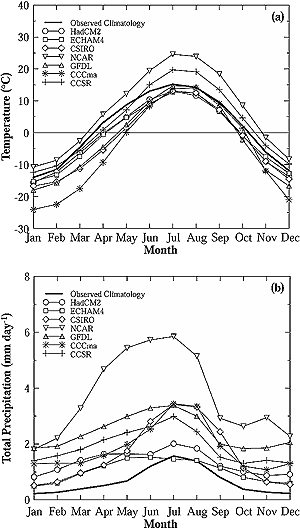|
11.1.3. Scenarios of Future Climate Change
Increases in atmospheric concentrations of GHGs from anthropogenic activities
would warm the earth-atmosphere system. The radiative forcing inferred from
likely future increases in GHGs and sulfate aerosols as prescribed under IS92a
emission scenarios (Leggett et al., 1992; IPCC, 1995) has been used in recent
numerical experiments performed with coupled atmosphere-ocean global climate
models (AOGCMs). Projections of future regional climate change and also most
of the impact assessment studies for Asia cited herein are based on these numerical
experiments (see Chapter 3 for further details).
To develop climate change scenarios on regional scales, it is first necessary
to examine if the coupled AOGCMs are able to simulate the dynamics of present-day
regional climate. The multi-century control integrations of AOGCMs unforced
by anthropogenic changes in atmospheric composition offer an excellent opportunity
to examine the skill of individual models in simulating the present-day climate
and its variability on regional scales (Giorgi and Francisco, 2000; Lal et al.,
2000). A model validation exercise carried out for Asia and its subregions has
indicated that each of these models shows large seasonal variations in surface
air temperature over boreal Asia and only small seasonal variations over southeast
tropical Asia (Figure 11-2). However, many of the AOGCMs
have only limited ability for realistic portrayal of even large-scale precipitation
distribution over Asia. Seasonal variations in observed precipitation over the
South Asia region as a consequence of summer monsoon activity are poorly simulated
by most of the models (Figure 11-3). Moreover, none of
the seven models can reproduce the observed precipitation climatology over the
Tibetan Plateau (Figure 11-4). Based on the pattern correlation
coefficients and root mean square errors between the observed and model-simulated
seasonal mean sea-level pressure, surface air temperature, and rainfall patterns
over land regions of Asia and other relevant considerations in this validation
exercise, the HadCM2, ECHAM4, CSIRO, and CCSR/NIES AOGCMs (developed at U.K.
Hadley Climate Centre, German Climate Research Centre, Australian Commonwealth
Scientific and Industrial Research Organisation, and Japanese Center for Climate
System Research/National Institute for Environmental Studies, respectively)
are rated to have some skill in simulating the broad features of present-day
climate and its variability over Asia (Lal and Harasawa, 2000).
|

Figure 11-2: Validation of simulated and observed area-averaged
annual cycles of surface air temperature over boreal (a) and southeast
Asia (b) regions.
|
|

Figure 11-3: Validation of simulated and observed area-averaged
annual cycles of surface air temperature (a) and precipitation
(b) over south Asia.
|
|
|

Figure 11-4: Validation of simulated and observed area-averaged
annual cycles of surface air temperature (a) and precipitation
(b) over Tibetan Plateau.
|
|
|